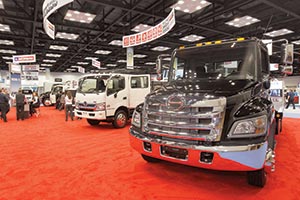December Medium-Duty Sales Push Segment to Strongest Annual Finish in Seven Years

This story appears in the Jan. 26 print edition of Transport Topics.
U.S. retail sales of Classes 4-7 trucks climbed in December to 18,731 units, the highest monthly total in more than seven years, according to WardsAuto.com.
Last month’s figure, which was the best since August 2007, represented a 16% increase from a year earlier and a 41% jump from November.
The December sales lifted the 2014 total to 186,342 units, up 12% from a year earlier and making it the best year for the medium-duty market since 2007.
Steve Tam, vice president at ACT Research, attributed 2014’s sales increase to economic growth and an improved business outlook for medium-duty operators.
“They’re pretty optimistic about the future,” he said. “They’ve weathered some pretty tough times and have held onto their equipment for a long time. They’re ready to replace some of that stuff that’s really old and long in the tooth.”
According to Ward’s data, medium-duty sales have risen consistently each year since 2009, when they dropped to 104,888 after the housing market crash.
Just three years earlier, sales had crested at 260,573 in 2006, driven in part by heightened demand ahead of tighter federal emissions standards in 2007, although that was less of a factor for the medium-duty market than it was for Class 8, ACT’s Tam said.
“It was a consideration on the medium-duty side but not nearly of the magnitude it was for Class 8,” he said.
The technology changes needed for the medium-duty engines were minor, compared with the heavy-duty trucks, Tam said. As a result, medium-duty vehicles didn’t see the same cost increase and performance deterioration that the Class 8 buyers did at that time, he added.
ACT projects that retail sales of Classes 5-7 vehicles in North America will increase to 219,600 units in 2015, up from about 212,100 in 2014.
However, the firm expects medium-duty production to decline to 223,000 vehicles, from 226,000 last year, as the industry draws down inventories.
Tam predicted that the recent drop in fuel prices will have little effect on the medium-duty market because most fleet operators remain local and don’t rack up miles like the heavy-duty longhaul business.
“It’s not something people plan their lives around, like they do on the Class 8 side,” he said.
In a recent report, the National Automobile Dealers Association said it expects the medium-duty sector to “further benefit from increasing demand in the construction sector as the housing market moves from recovery to expansion in the second half of 2015.”
Ward’s data showed that medium-duty sales growth in December was led by a 24% jump in Class 7 sales, to 5,297 vehicles. Full-year Class 7 sales rose 14%, to 54,178.
Class 6 sales climbed 19% to 4,733 units in December and increased 9% to 51,705 for the full year.
Combined sales of Classes 4 and 5 trucks rose 10% to 8,701 in December. Annual sales rose 12% to 80,459.
Nearly all manufacturers posted higher sales volumes in 2014.
Freightliner’s medium-duty sales rose to 47,347 vehicles, up 8% from a year earlier.
Navistar Inc. sold 26,081 of its International trucks, up 9% from 2013. Last year, the company continued transitioning its medium-duty lineup to selective catalytic reduction aftertreatment technology.
Hino’s 2014 sales climbed 23% to 9,130 units.
Paccar Inc.’s operating companies also reported higher medium-duty sales. Kenworth Truck Co.’s sales jumped 31% to 5,891 units, while Peterbilt Motors Co.’s rose 8% to 5,207.
Isuzu’s sales rose 23% year-over-year, to 14,327.
Sales for Mitsubishi Fuso, however, fell 13% to 1,582.
Ford Motor Co.’s sales grew 7% to 62,376, while Dodge Ram’s surged 32% to 14,401.

